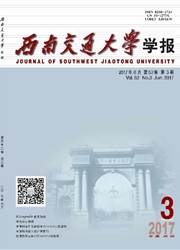

 中文摘要:
中文摘要:
为解决传统的ALINEA(asservissement linéaire d'entrée autoroutière)匝道控制算法未考虑城市快速路入口匝道排队溢出,造成关联交叉口交通拥堵等问题,在经典的ALINEA匝道控制算法的基础上,提出了一种新的基于主干道车流量预测的城市快速路入口匝道控制方法.该方法采用遗传算法优化的小波神经网络来预测城市快速路交通流量;引入主干道车流可插入间隙和匝道排队分级控制原则,实现了对城市快速路入口匝道控制率的动态调节.通过微观仿真实验比较两种算法的控制效果.结果表明:与传统的ALINEA匝道控制算法相比,新的控制方法不仅能够有效保证主线交通通行能力,同时还使匝道平均旅行时间减少了24.8%.
 英文摘要:
英文摘要:
The traditional ALINEA ( asservissement lineaire d’entree autoroutiere) ramp control algorithm does not take into consideration the ramp queue overflow of urban expressways, and may thus cause traffic congestion at the apposite expressway intersection. By incorporating the classical ALINEA ramp control algorithm, a new on-ramp control method for urban expressways has been proposed, based on traffic-flow prediction for urban expressways. The proposed method focuses on developing a wavelet neural network optimized by a genetic algorithm ( GA-WNN) for predicting the traffic-flow of an urban expressway. The gap acceptance theory and the grading principle of ramp queues have also been introduced in the proposed methodology, thus leading to the realization of dynamic regulation of the ramp control rate for urban expressways. The control effects of the classical ALINEA and the proposed algorithm were compared through a micro-simulation experiment, and the results show that the proposed model can effectively improve the capacity of the arterial road, and can reduce the average trip time of the ramp by approximately 24. 8% .
 同期刊论文项目
同期刊论文项目
 同项目期刊论文
同项目期刊论文
 期刊信息
期刊信息
